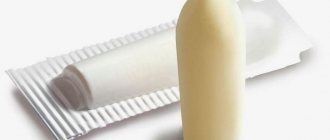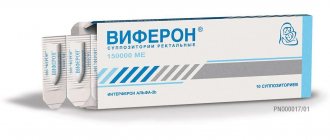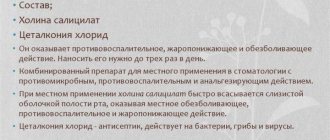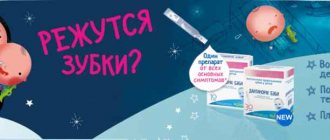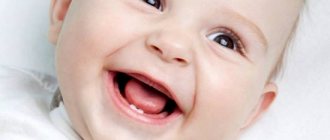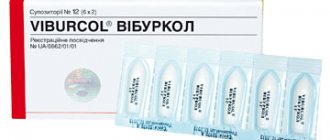What to do if your child has a fever? This question sooner or later arises in every parent who is concerned about the health of their child. But not all mothers and fathers know what temperature can and should be lowered. So, for example, in newborns and babies up to one year old the indicator is up to 37.5-38 degrees, which for us adults is considered elevated, and is the norm. The baby is one month old – does he have a fever? Reduce it only if it rises above 38-38.5.
As for older toddlers, for them this “threshold” is 39-39.5. If the thermometer shows a lower temperature, you should not knock it down. Remember that a child’s fever is an excellent opportunity for the body to fight the infection on its own. Give your baby the opportunity to boost his immunity!
How to reduce a child's temperature?
Now let’s talk about the medications that should definitely be in your first aid kit if a baby is growing up in the family. Thus, pediatricians prohibit the use of drugs such as:
- Aspirin;
- Analgin;
- Nise.
The baby can only be given medications that contain Paracetamol or Ibuprofen. Even if the child has no symptoms, they must be correctly calculated based on the baby’s weight and measured using a special syringe or measuring spoon. You should not use ordinary teaspoons for these purposes, and it is better to completely forget about the concept of “by eye”.
How to reduce a child's temperature?
Doctors advise using only one drug from the above - with Paracetamol or Ibuprofen in the composition. If the temperature drops poorly or does not drop at all, such medications can be alternated. But you can’t give your baby the combined drug Ibuklin.
Please note that it is not at all necessary to reduce the temperature to normal. It is enough just to knock it down a little for the baby’s well-being to improve at least a little. Don’t forget to feed your little one, because in case of high temperature the loss of fluid increases. Pediatricians say that babies need to drink 100 ml of water per 1 kg of weight.
Viburkol suppositories for teething
“Viburkol” are suppositories that are classified as homeopathic preparations because they are made on the basis of natural plant ingredients. This medicine has a sedative, anti-inflammatory and analgesic effect.
The suppository contains five components – 4 plant and 1 mineral:
- Chamomile – relieves pain and soothes;
- Belladonna (belladonna) – enhances the effect of chamomile;
- Nightshade - acts as a tranquilizer;
- Plantain – has a sedative property;
- Lumbago – normalizes hormones and relieves pain;
- Also, in the manufacture of rectal suppositories, solid fat is used.
The candles are torpedo-shaped in yellow and white. Six tablets are contained in a cell package and twelve in a cardboard package. Manufactured by a company from Germany, Heel GmbH.
“Viburkol” is applicable to children of different ages, including newborn babies. The dosage of the medicine is determined individually by the pediatrician.
This medicine can be used together with other drugs in the treatment of various infections, to reduce fever and fever, to eliminate disorders in the digestive tract. An important property of the drug is that it relieves nervous excitement when baby teeth are cutting.
In medical practice, the medicine has proven itself to be excellent for teething in children. All components of the suppository help reduce nervous tension in the baby, soften pain, eliminate swelling of the gums and relieve feverish chills. Reading the instructions for use of the drug, you can see that there are no taxes for this medicine. After all, homeopathic suppositories are mostly exclusive. However, if necessary, they can be replaced with another homeopathic medicine. On most forums and online groups there are practically no reviews that would negatively describe the effect of “Viburkol” . Most commentators agreed that if you introduce suppositories when teething, you can notice a significant improvement in the child’s well-being. He becomes calmer and salivation decreases.
The price of the drug differs in different localities and pharmacies. On average, it ranges from 200 to 400 rubles. You can buy candles without a prescription. Is it possible to send medicines from Germany to Russia?
What to do if your baby gets chickenpox?
Has your child caught chickenpox? Of course, this acute viral disease can also cause high fever. How to proceed in this case?
The most important thing is to choose an antipyretic drug for your baby. Under no circumstances should you use Nurofen. To combat high fever during chickenpox, medications containing Paracetamol are suitable.
What to do if your child has a fever?
Does your baby have a fever? Then you can’t hesitate - you need to urgently consult a doctor. Especially if it is accompanied by:
- rash;
- neck muscle tension;
- abdominal pain;
- vomiting.
But don’t panic: fever is typical for most common viral respiratory infections and high temperatures - about 40 degrees. This is how our body responds to infection. The pediatrician will simply examine the child and select the right treatment for him, taking into account the severity of the disease.
Symptoms of the appearance of wisdom teeth
As a rule, the eruption of figure eights is accompanied by certain symptoms.
Pain in the gums.
It can be different: aching, pulsating or sharp. This all lasts for several days, or maybe the entire time the tooth grows.
Swelling and swelling.
Sometimes during the period of teething, swelling or swelling appears on the gums. In case of severe swelling, which is accompanied by severe pain and fever, it is recommended to consult a doctor.
Increased body temperature.
An abnormally growing wisdom tooth may be accompanied by an increase in temperature. If the values do not go beyond 38 degrees, there is no need to worry - this is the norm. If the readings are higher, you should make an appointment with your dentist.
A sore throat.
Occurs during an infectious process. During teething, the mucous membrane is very vulnerable, so during this period it is necessary to devote more time to hygiene in order to avoid infection.
What temperature should be lowered in a child with influenza and ARVI?
High temperature forces the child's body to turn on its protective function. In this case, there may be a general deterioration in the form of malaise and headaches. The child becomes lethargic and whiny, which brings a lot of anxiety to parents. Before bringing down a child’s high temperature, you need to clarify significant nuances.
A slight increase in temperature does not lead to serious consequences and does not require any measures to be taken. Parents need to have reliable information about what temperature should be lowered. Improper actions can cause weakened immunity. There is a risk of developing possible complications and the disease may become protracted.
Cases when you need to bring down the temperature in children:
- 37.2-37.9°C (low-grade fever) – should be taken for newborns up to 2 months of age if indicated;
- 38.0-38.9°C (febrile) – antipyretics must be given in all cases;
- over 41.0°C (hyperthermic) - you need to call an ambulance if the drugs do not lower the readings on the thermometer.
It is necessary to call an ambulance if febrile spasms appear - this is intolerance to high temperature, an individual feature of the child’s body. This condition usually does not occur in children over 6 years of age (provided there are no pathologies in the central nervous system).
Chronic or acute diseases in cardiology, neurology or lung disease require lowering the temperature in children if the readings are above 38°C. Otherwise, complications from the heart, nervous system and respiratory organs cannot be ruled out.
If you have difficulty lowering your temperature, you should immediately seek medical help. If the thermometer has barely reached 37°C, and the child looks lethargic and his health is only getting worse, you should not expect a further increase in the readings on the thermometer.
Symptoms of wisdom teeth erupting
Features of growth
Symptoms of the appearance of wisdom teeth
If your wisdom tooth grows incorrectly
How to relieve pain when wisdom teeth erupt
If a wisdom tooth grows during pregnancy
Eights, also known as wisdom teeth or third molars, are the most “problematic” teeth. They are the last to erupt, from about 16 to 30 years of age. At this age, the jaw is already formed, so the eights simply do not have enough space in the dentition, so when they appear, they begin to cause discomfort.
How to properly lower the temperature at home?
Effective folk ways to reduce fever without medications in children:
- A drink made from cranberries is a unique diaphoretic that reduces fever. The berry is useful for containing vitamins and accelerates the elimination of decay products.
- Chamomile tea is an excellent anti-inflammatory remedy. To prepare the infusion, pour a tablespoon of chamomile into a glass of boiling water, let it brew for 2 hours, drink up to 5 times a day.
- Elderberry decoction effectively helps reduce fever. It is enough to take 50 g of elderberry and pour boiling water (200 ml) over it.
- Linden tea – gives excellent results when consumed with honey. The child will sweat profusely, which will reduce body temperature due to the evaporation of excess moisture from the skin.
You can wipe the child's body with a terry towel moistened with water at room temperature. Applying a heating pad with ice to large vessels helps. Wrapping in a damp towel or sheet is also recommended.
Medications
Before lowering your child’s temperature at home with medications, you must carefully study the instructions for use. Classic drugs can be bought in pharmacies, choose the dosage and form that is needed and choose the best option depending on age and indications.
The baby can only be given medications that contain paracetamol or ibuprofen. Paracetamol is contained in Panadol and Cefekon, ibuprofen is found in Nurofen and Ibufen. For babies, these products are available in the form of syrup, which, unlike tablets, has a sweet taste and is more convenient to dose.
Standard antipyretic drugs:
- "Panadol". Suitable for use on infants. The drug is indicated for colds, teething, otitis media, whooping cough and other infections. Prescribed to children aged 3 months and older in an individual dosage.
- "Efferalgan." Used as an analgesic and antipyretic. Rectal suppositories can be used to relieve fever in infants 3 months and older. Unlike medications taken orally, it does not cause vomiting and does not affect the gastrointestinal tract.
- "Ibufen." Has analgesic and antipyretic properties. In childhood, this drug is used in a dosage calculated depending on the weight and age of the child.
- "Paracetamol". An effective antipyretic and analgesic. It can be alternated with ibuprofen. If there is vomiting, you can use suppositories (suppositories).
- "Cefekon D". Available in the form of suppositories, recommended for use from 3 months to 12 years. Important advantages of the drug are its low cost and versatility. In addition to reducing temperature, it has an anti-inflammatory and analgesic effect.
A child's body can react to different medications differently, so you should experiment in practice to determine a more effective remedy, based on the pediatrician's recommendations.
When taking medications, you should follow a number of rules:
1. You cannot give several medications at the same time.
2. Drugs can be alternated, but the interval between taking medications should be 2-3 hours.
3. It is recommended to dose syrups using a measuring spoon or syringe, which are included in the kit.
4. If a child 1 year or younger is sick, it is recommended to use suppositories. Older children take tablets and capsules easily. Without a doctor's recommendation, antipyretic drugs can be prescribed to children for no longer than 3 days in a row and no more than 4 times a day.
5. Parents must understand that high body temperature is just a symptom indicating a specific disease. Taking antipyretics is not a treatment; it is only necessary to alleviate the child’s condition before the doctor arrives.
Tsefekon D
Cefekon D is an antipyretic and analgesic agent in the form of suppositories for use in pediatrics. The administration of drugs into the rectum (rectal administration) has a number of advantages over the more common oral administration, and in some situations it is the only acceptable one (for vomiting, difficulty swallowing, the need for local therapeutic effects on the rectum and/or colon). In pediatrics, suppositories seem to be an indispensable dosage form, especially for the youngest children who have not yet learned to swallow a tablet or suspension on demand and are not old enough to receive injections. Aspects of rectal administration have been extensively studied by pharmacologists. Penetration of active substances into the circulatory system through the rectal mucosa through passive movement of the substance from an area of higher concentration to an area of lower concentration. The rectum is penetrated by an extensive network of capillaries and larger vessels, and therefore pharmacological substances are well absorbed from its surface. It is important that substances absorbed in the lower rectum do not pass through the liver and are not subject to metabolic transformations. Rectal administration of drugs protects the gastrointestinal mucosa from local irritation. The Russian pharmaceutical industry produces a number of medicines in the form of rectal suppositories, among which Cefekon D occupies a prominent place. The active ingredient of the drug, paracetamol, is very widely used in pediatrics.
The peak concentration of paracetamol in the blood is observed 1 hour after rectal administration (when taking the tablet form this happens faster - after 30-45 minutes). In infants, the bioavailability of the drug is higher than in older children. The severity of the antipyretic effect of paracetamol when administered into the rectum is the same as when administered “per os”. Cefekon D is effective for influenza, acute respiratory infections, pain syndromes of various origins (including headaches, inflammation of peripheral nerves, toothache, injuries, etc.). The drug can be used in children starting from 6 months of age. At an earlier age (1-3 months), a one-time dose of Cefekon D is possible to reduce the temperature after preventive vaccinations. Contraindication to the use of the drug is individual intolerance to paracetamol. The optimal time of administration is after bowel movement. If prompt administration of the drug is necessary, you can do a cleansing enema instead of waiting for a bowel movement. The dose is calculated depending on the patient's body weight according to the table given in the package insert. Duration of the drug course: no more than three days when using the drug as an antipyretic and no more than five days when using the drug as a non-narcotic analgesic. Exceeding the established duration of pharmacotherapy is possible only in agreement with the doctor.
What should you not give to children?
Reducing a child’s temperature is not difficult - today there are many drugs on sale that relieve fever in a short time. But first you need to consult with a qualified pediatrician, because self-medication can affect the baby's health.
If the readings do not exceed 38.5°C, there is no need to lower the temperature, because The body independently produces antibodies that help destroy viruses - so to speak, it fights the infection.
Medicines that are not recommended for children:
- amidopyrine, antipyrine and phenacetin (many side effects);
- acetylsalicylic acid (reduce the number of platelets, causing bleeding, allergic reactions, etc.);
- analgin and other drugs containing metamizole sodium as an active substance (side effects occur, such as suppression of hematopoiesis, severe allergic reactions, etc.).
These drugs are not recommended for use without the advice of a doctor. When you need to bring down the temperature, give preference to another medicine.
Candles “Viferon” for teething
“Viferon” is a very powerful remedy that stimulates the immune system and also has an effect that fights viruses. The main active substance alpha is 2B interferon. It is produced synthetically. It has an effect prone to immunomodulation. After the medicine enters the body, the activity of cells that protect the body from infections and various types of bacteria is activated.
The basis of this drug is fat and cocoa. They help maintain shape and provide density to the candles. Other substances included in the composition can be found in the attached instructions:
- sodium ascorbate;
- disodium dihydrate;
- ascorbic acid;
- polysorbate;
- a-tocopherol acetate;
These substances have an enhancing effect and form the solid basis of the candle. After introducing the drug into the human body, the fats become soft, interferon and other components are released.
The form of the medicine is such that it can be divided into several parts if there is a need to take a different dose.
“Viferon” suppositories contain vitamins E and C, which is beneficial for the baby’s immunity. Although the drug will not help if the child has a high temperature and fever, doctors prescribe it. After all, when teething, the child’s immunity noticeably decreases due to sleep disturbances and a runny nose.
Infants who were born prematurely with a gestational period of less than 34 weeks are prescribed 150,000 IU, one suppository three times a day after eight hours every day. You need to light the candles for five days. According to the doctor's instructions, the course can be extended, but not earlier than after five days.
Children under 7 years of age with a gestational period of more than 34 weeks are prescribed 150,000 IU, one suppository twice a day every twelve hours for five days.
The healing properties of “Viferon” are as follows:
- There is an active fight against viruses through the destruction of the genes of viruses that are inside the human body;
- The production of immunoglobulin A is enhanced and the amount of immunoglobulin E is restored;
- The work of cells and humoral components is restored;
- Cell division is significantly reduced where inflammation occurs;
- Has an effect that counteracts the appearance of tumors;
- Helps eliminate elevated body temperature (at a temperature of 38 degrees, suppositories are used according to a specific algorithm);
- The activity of phagocytes and macrophages increases, which ensure the elimination of viruses, bacteria and various allergens;
- Stimulates lymphocytes;
- The presence of ascorbic acid in the preparation enhances the therapeutic effect and resists inflammation.
The use of a suppository promotes the production of human interferon - a human protein that is produced by the human body when pathogenic fungi and viruses enter it. There are several varieties of this protein. The most active against viruses is Interferon alpha 2B.
This medicine is contraindicated for persons with individual intolerance to the substances that make up its composition. In some cases, itching and skin rashes may occur, but this phenomenon is completely reversible - it disappears 72 hours after you stop therapy.
It is best to store candles in the refrigerator, since the correct storage conditions are a temperature of no more than ten degrees. When using candles, you should definitely pay attention to its expiration date. If it has expired, then using the medicine is strictly prohibited.
Is it necessary to bring down a child’s temperature to 36.6?
If, after using antipyretics, the readings decrease by 0.5°C within an hour, then the process is normal. Do not aim to reach 36.6°C immediately. This can cause serious overload of the child’s body, which can lead to a deterioration in overall well-being.
The ideal temperature would be 37-37.5 degrees. After some time, a jump may occur again. This occurs because the active component of the medicine is excreted from the body and ceases its effect. If several hours have passed after taking the drug, you can give the child another dose. It is very important to observe time intervals between doses and monitor temperature readings.
With an effective fight of the immune system against pathogenic microbes and with a competent approach to treatment, recovery, as a rule, is 3-5 days.
“Cefekon” suppositories for teething
“Cefekon” is an antipyretic suppository that has analgesic properties. They help relieve fever and pain. Applicable in the treatment of various symptoms. In trade they have the name “Cefekon-D”. Aimed at treating children, mostly newborns. The main advantage of the medicine is that it does not affect the balance of water and salt in the human body, and taking it does not lead to dehydration during fever. Another advantage of these suppositories is that they are eliminated from the body very quickly. The composition of the drug components is safe for children.
“Cefekon” is produced in the form of white and yellow torpedo-shaped candles. Available in 50, 100 and 250 mg.
The main component of “Cefekon” is paracetamol. It is an active substance. It is able to relieve pain and eliminate high fever as it has an anti-inflammatory effect. Another component is vitepsol; it acts as a base when creating these candles. Since the composition of the medicine is quite uniform, it is very effective and not dangerous for the child’s body.
The effect of the drug begins 25-30 minutes after its use.
Before using the medicine, you should carefully study the instructions. The main condition for use is an enema given to the child during the procedure. For an enema, a chamomile solution or plain warm water is usually used. Next, you need to get rid of the packaging and warm up the candle in your hands.
Age Weight Dosage
1-3 months 4-6 kg. 1 suppository (pack of 50 mg.)
3-12 months 7-10 kg. 1 suppository (pack of 100 mg.)
12 months – 3 g. 11-16 kg. 1 suppository (pack of 200 mg.) or 2 suppositories (pack of 100 mg.)
3-10 years 17-30 kg. 1 suppository (pack of 250 mg.)
10-12 years old 31-36 kg. 2 suppositories (pack of 250 mg.)
A newborn up to three months should be administered 1 suppository at a minimum dose of 50 mg. After taking the drug, it is important to monitor the child’s well-being, as there is a risk of intestinal mucosal allergies. It is very important to store the medicine correctly. Storage for no more than two years at a temperature not lower than twenty degrees. Candles are quite common and purchasing them does not cause problems for buyers. The price for “Cefekon” varies from 50 to 100 rubles. Available in almost every pharmacy.
The main analogue of Cefekon is Paracetomol, Paracetomol-Alpharm and Children's Panadol.
“Cefekon” is a medicine that should be in every family with small children. After all, it has a gentle effect and has almost no contraindications.
How to help a child’s body fight infection?
Regardless of whether you follow the recommendations on what temperature to lower in children, you must take care to create the necessary conditions for the patient. All family members should improve the quality of personal hygiene: wash their hands, wear disposable gauze bandages, etc. You also need to provide the child with separate cutlery and dishes.
Recommendations for a speedy recovery:
1. A sick child must remain in bed.
2. It is necessary to ventilate the room in which the baby is located (the influenza virus and other microorganisms are concentrated in musty air).
3. Care should be taken to humidify the air (at the same time, the mucous membranes of the nose and larynx do not dry out; this improves local immunity and promotes well-being).
4. You should ensure that you drink plenty of fluids (virus breakdown products are eliminated through the kidneys, which reduces the load on the body).
5. The baby’s clothes should be light, preferably made from natural fabrics.
6. It is considered normal for a baby to have no appetite. You should avoid spices, citrus fruits, and dairy products, which can cause irritation of the gastric mucosa. A hot bath at a high temperature is not the most pleasant feeling, but cool (not cold) water can help normalize the indicators.
7. It is recommended to use the bath together with antipyretics, and not instead of them. You can also get some relief by applying a cool compress to your forehead.
Temperature during teething: causes, duration
When teething, the child's body experiences severe stress and reacts to this with an increased temperature. In order not to confuse a common cold and teething fever, you need to know what exactly happens when teeth are cut.
The reason for the increase in temperature during teething Temperature does not just happen. The child’s body reacts in this way to the inflammation of the gums, through which the tooth will soon emerge. At this time, immunity at the site of the future tooth decreases, and various microorganisms begin to become active, which also cause fever. Up to a year, teething occurs more or less calmly and does not cause severe inconvenience, but after a year, when fangs begin to erupt, which take longer to appear, the baby may experience pain, accompanied by fever, for up to several weeks. Often the temperature rises not because of inflammation of the gums, but because of viruses that have entered the body or infection due to reduced immunity. The body uses it to fight them, because they are not able to exist at high temperatures, so they die.
How much can the temperature rise? How much the temperature rises is individual for each organism. Normally, it can vary from 37.5 to 38.5 degrees. It is necessary to measure the temperature every half hour or hour, because in young children it can rise very quickly because their body is not yet able to properly exchange heat. If the temperature begins to reach 39 degrees, you must immediately call an ambulance, because this may mean the appearance of various complications.
Duration Regardless of the examples given, all organisms react differently, so for different children everything can develop according to its own scenario. Usually the temperature lasts 2-3 days and disappears when the tooth erupts. There are also cases when the temperature lasts for 5 or even 7 days, and the temperature can rise and disappear completely after a few hours. Be that as it may, a doctor still needs to be called to examine the baby. To exclude complications and a number of other diseases, so that if something happens, they can be treated as early as possible.
What are the symptoms besides fever? Temperature is not the only sign of teething. At the same time, a runny nose may occur due to the spread of swelling from the gums to the nasal mucosa. This happens when the upper teeth erupt. Also one of the symptoms is excessive salivation and weak stool of the baby.
What symptoms should you be wary of? Due to reduced immunity, the child’s body is not able to fight many viruses and infections. The following signs may indicate their presence: • the nose is very stuffy, and snot flows from it in large quantities. This means that rhinitis has joined the edema, it must be treated; • diarrhea. Very rarely it appears along with a temperature, but it still happens. This could mean some kind of intestinal infection acquired by the baby through toys; • cough. Due to severe drooling, children do not always have time to swallow saliva, so they can sometimes choke on it, resulting in coughing. If the cough is repeated systematically and there are signs of sputum, then inflammation of the respiratory tract has been added to the temperature; • reddened throat. In addition to the nasal mucosa, swelling can also spread to the mucous membranes of the throat. This may mean the appearance of pharyngitis or acute respiratory infections; • nausea and vomiting. They occur at a very high temperature, perhaps this is a symptom of an intestinal infection or damage to the nervous system. If your baby exhibits these signs, you should immediately consult a doctor who will prescribe the necessary treatment, regardless of the presence of fever.
What measures to take in case of high temperature? Many parents begin to give antipyretic and antiviral drugs when the temperature rises slightly. This cannot be done, because you need to allow the body to fight the virus on its own. Abuse of such drugs can lead to addiction, and the body will not be able to cope with infections and viruses on its own in the future. Pediatricians advise not to lower the temperature until it reaches 38 degrees, because you need to let the body fight. If the effectiveness of antipyretic drugs is low, you can wipe the baby with slightly cool water or rub it with an alcohol solution with the addition of vinegar. Sometimes parents resort to a method such as homeopathy, but with the help of these remedies they will not be able to effectively reduce the temperature, although they can generally improve the condition of the baby. If the temperature does not subside for more than 3 days, you should consult a doctor.
Is it possible to walk when there is a fever? If the baby’s health is normal and the temperature is not too high, then a walk in the fresh air will only bring benefits. Only the child needs to be dressed according to the weather. You need to walk calmly so that he doesn’t get overtired. Even if you are sure that the temperature is a consequence of teething, you still need to call a doctor who will make an accurate diagnosis and prescribe the correct treatment. Self-medication in this case is unacceptable, because if you make a mistake, you can harm the baby’s health.
Sign up for treatment and consultation with a pediatric dentist!

